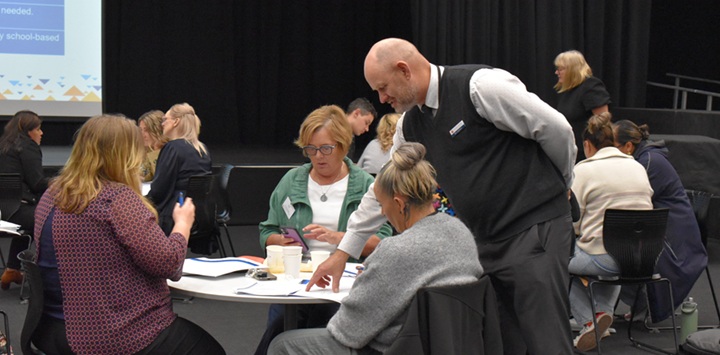From control to curiosity: transforming leadership conversations
By Ben Laybourn on September 26, 2025 in Leadership
This blog explores the hidden patterns behind leadership conversations - and how shifting from control to curiosity can unlock deeper learning and real change.
You’ve set the goals. You’ve rolled out the strategy. You’ve got good people on your team. And yet… something’s still not working.
If you’ve ever walked away from a leadership conversation thinking, “That didn’t land the way I hoped,” you’re not alone. Despite our best intentions, some deeply embedded patterns in how we lead conversations may be getting in the way of real change.
Research from Viviane Robinson, Claire Sinnema, and Jacqui Patuawa offers a powerful insight: what we say we believe and what we actually do - especially under pressure - are often two very different things.
The invisible drivers of leadership: theories of action
At the core of their work is a deceptively simple idea: our actions are shaped by hidden mental maps - what Argyris and Schön called our theories-in-use. These often don’t match our espoused theories, or what we say we believe. We might say we value collaboration, but when conflict arises, we shut it down. We might say we want feedback, but when it’s tough to hear, we change the subject.
That gap between intention and action is where leadership growth lives.
Two patterns that shape your conversations
Robinson and her colleagues describe two core patterns of action leaders tend to follow.
Model 1: Defensive reasoning (Control-focused thinking)
Ever been in a meeting where people avoid honest feedback, try to control the narrative, or focus on looking competent over solving the actual problem?
That’s Model 1 in action - Control-focused thinking. It’s driven by:
a need to minimise risk and embarrassment
unilateral control over outcomes
suppression of uncomfortable truths.
The result? Leaders tend to stay in this thinking pattern, addressing surface issues without ever confronting the deeper beliefs and assumptions that drive them.
Model 2: Productive reasoning (Learning focused thinking)
Now imagine a conversation where people share data openly, test their assumptions, and make decisions based on valid information and shared understanding.
That’s Model 2 - learning-focused thinking. It’s characterised by:
curiosity over control
transparency and joint inquiry
commitment to learning, even when it’s hard.
This approach enables double-loop learning, where beliefs and values are examined and reshaped, unlocking deeper, more sustainable improvement.

Shifting gears: Leading by Learning in action
This is where the Leading by Learning framework comes in. Developed by Robinson and implemented widely by Patuawa and her team, it provides a practical way to shift leadership conversations from persuasion and control to inquiry and learning.
Leaders are encouraged to:
test their own beliefs by actively seeking disconfirming evidence
inquire into others’ reasoning rather than assuming they know best
co-construct solutions based on shared meaning and transparent data.
It’s not always comfortable - but it is powerful. This shift builds trust, strengthens teams, and enables more effective problem-solving.
What about teacher inquiry?
It’s not just leadership conversations where this matters. Claire Sinnema’s work on teaching as inquiry demonstrates that teachers, too, often remain in single-loop learning, tweaking surface strategies without questioning their core beliefs about teaching or student capability.
Authentic teacher inquiry - the kind that leads to real improvement - requires the same shift leaders are being asked to make from defending what we believe to testing it.
Professional learning, Patuawa argues, must go beyond offering new tools. It must challenge the beliefs and theories that determine whether those tools are ever picked up and used effectively.
What does this mean for you?
Next time you're heading into a tough conversation - about student underachievement, teacher practice, or team dynamics - pause and ask:
Am I here to control the outcome, or to learn something new?
Am I prepared to test my own thinking, or only challenge others?
Will this conversation help us surface what's really going on?
Because shifting from defensive routines to learning conversations isn’t just a leadership technique - it’s a mindset.
And that mindset - It doesn’t just change conversations. It changes schools.
Want to build this capability in your team?
Explore our workshops to develop interpersonal skills and habits that power deeper improvement.
Leading by Learning: Introductory workshop – develop knowledge and increase understanding of the theory and practice of being learning-focused.
Leadership Unlocked - explore the Collaborative Complex Problem-Solving (CCPS) model to learn how to address complex issues affecting student outcomes.
Want to find out more?
Other articles you might like
In this blog, Ben unpacks how “theories of action” shape our problem-solving, often invisibly, and why embracing double-loop learning is key to sustainable school improvement. A must-read if you're ready to move from quick fixes to deep, lasting change.
In the blog, Ben discovers how middle leaders used deliberate conversations and evidence-based inquiry to transform student achievement in reading.
Quick fixes aren’t enough. Learn how Collaborative Complex Problem Solving helps schools tackle real challenges and achieve sustainable improvement.
